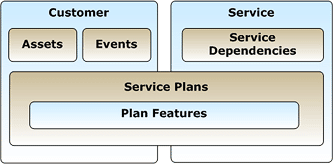This section provides details about the Plans Database schema.
The Managed Plans Namespace provides public access to Managed Plans functions, including services interaction and dependencies data stored in the PlanManager Database. In addition to making the procedures public the namespace APIs perform role based security checks before delegating the call to the underlying provider. Provisionable services use standard interfaces to provide their service characteristics and dependencies by way of core tables in a new PlanManager database. The following diagram shows the relationships between entities in the PlanManager database.

Database Tables
This core set of tables comprises:
- Customers - Any kind of customer - organization or
user.
- Services - An entity that can be provisioned.
- Service Dependencies - Models the concept that some
services have prerequisite services to which a customer must
subscribe through a plan, before the customer can subscribe to the
target service.
- Service Plans - Define the characteristics of a service
that can be differentiated in order to offer different service
levels. These differentiators are referred to as "features" of the
plan.
- Features - Characteristics of a service plan. Generic
feature types are defined and then assigned to a plan.
- Assets - Asset types can be defined by the implementer
of a given service namespace. Examples of the use of this feature
include SMTP domains, and Exchange Mailbox GUIDs.
- Events - Events related to a service can be logged to
record a provisioning event. The system implements some standard
events, but services can add their own events to the
system.